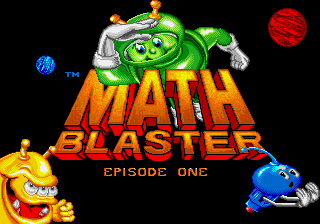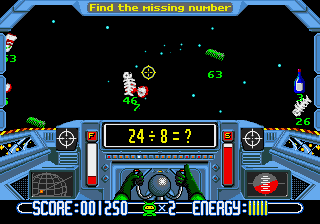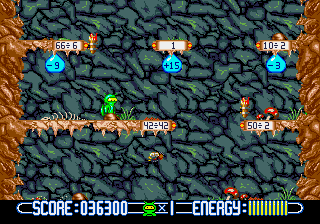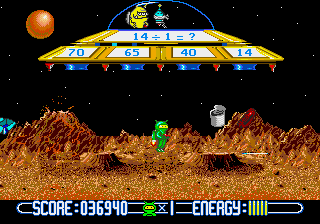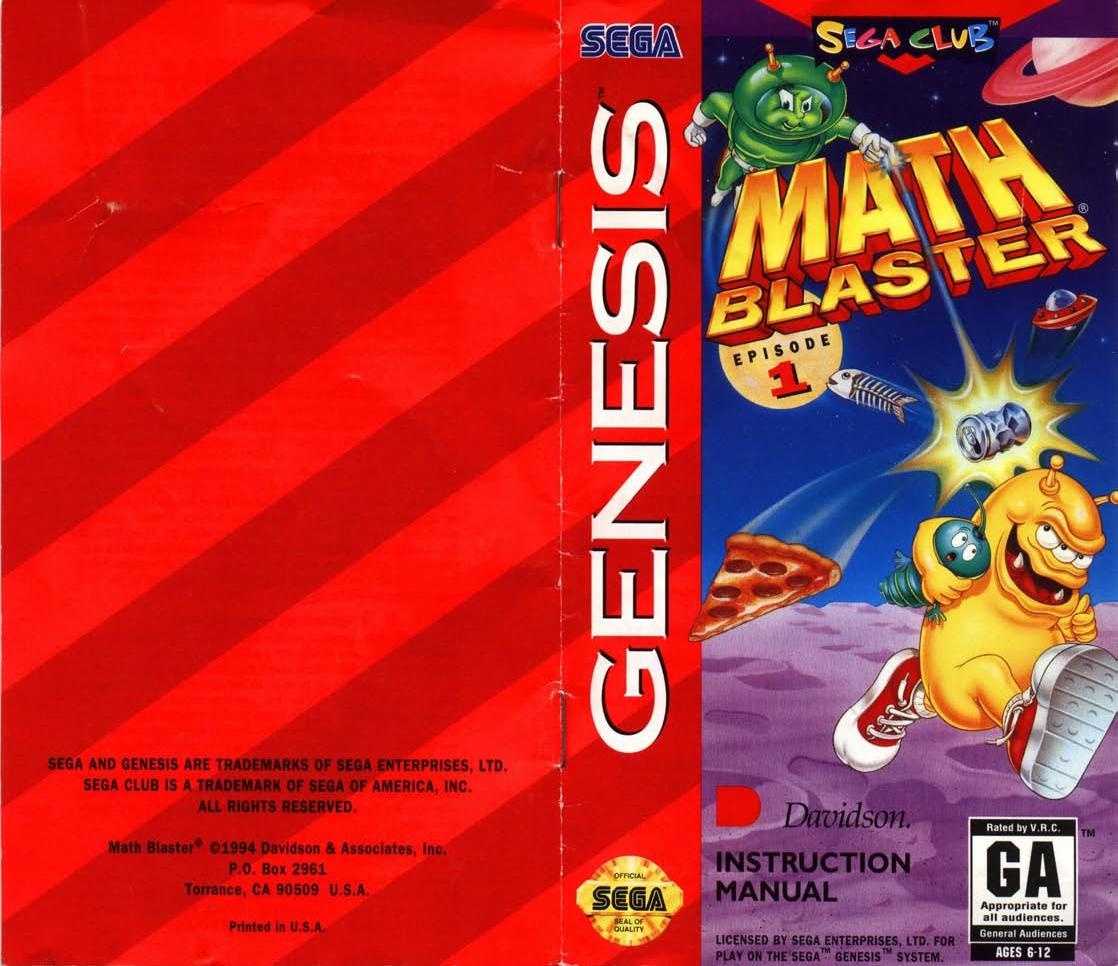Math Blaster: Episode 1 is a Sega Mega Drive math edutainment game developed by Spidersoft and Adrenalin Entertainment, and published by Davidson & Associates. A port of the publisher's titular 1987 Apple II game Math Blaster Plus!, it was released exclusively in the United States in September 1994.
Branded as part of Sega of America's children's-oriented Sega Club, Math Blaster: Episode 1 teaches basic mathematics skills, and features adjustable difficulty for players of different ages.
Story
The game's story is a simple rescue mission, centering on the efforts of Blasternaut to retrieve Spot from the clutches of the malicious "Trash Alien," who apparently litters out of sheer spite. The garbage he leaves behind consists primarily of empty containers and bad food, though coil-springs, boots and fish skeletons are also present.
In the opening scenes, Spot and Blasternaut are preparing for a journey aboard their rocket-like spaceship, only to find that the ship is not functional. Blasternaut, jumping to conclusions, sends Spot to repair a mechanism known as the "polytronic combustion regulator" and Spot reluctantly begins repairs, while Blasternaut goes below deck.
As Spot works, the Trash Alien flies by, captures Spot and departs, leaving garbage everywhere. Blasternaut, upon discovering this, contacts his superior officer, Galactic Commander, and notifies her of the situation. Galactic Commander immediately identifies the criminal and sends Blasternaut to collect the trash, use it to fuel his ship, track down the Trash Alien and destroy his spacecraft.
Gameplay
Gameplay in Math Blaster: Episode 1 is divided into three main components: Trash Zapper, Platform Chase and Final Battle.
|
|
Trash Zapper
|
The game's first part, where players blast pieces of trash to solve math equations. Move the cursor on the main screen to the trash that displays the correct answer to the problem in the Problem Viewer and hit fire to destroy it. The problems in the viewer come in two varieties: a basic equation such as 2 + 3 = ?, or a fill-in-the-blank equation such as 2 + ? = 5. Shooting the correct answer (shooting control defaults to  ) gives the player points and fills their F-Gauge. Only correct answers give points. There are also molecules floating around that can be shot, which refill some of the S-Gauge, but they do not give any points. ) gives the player points and fills their F-Gauge. Only correct answers give points. There are also molecules floating around that can be shot, which refill some of the S-Gauge, but they do not give any points.
On Normal Mode, Trash Alien vessels will attack you. They generally appear every five to ten seconds and hover in one spot. After another second or two they will fire small pellets that travel down the Main Screen. To deflect these shots, hit the shield button (defaults to  ) right as they reach the bottom of the screen. The ships themselves can be shot and destroyed for points. Shooting the correct answer on a piece of trash will freeze every alien ship on the screen. After filling the F-Gauge, the game will move on to a Bonus Stage. In this stage there are no aliens and no trash, only asteroids. Shoot as many asteroids as possible before time runs out. ) right as they reach the bottom of the screen. The ships themselves can be shot and destroyed for points. Shooting the correct answer on a piece of trash will freeze every alien ship on the screen. After filling the F-Gauge, the game will move on to a Bonus Stage. In this stage there are no aliens and no trash, only asteroids. Shoot as many asteroids as possible before time runs out.
|
|
|
Platform Chase
|
The game's second part, has Blasternaut flying through a platform-filled area trying to reach the top through ledges with number problems. Players thrust (defaults to  ) and can shoot enemies (defaults to ) and can shoot enemies (defaults to  ) to proceed. Scattered about are ledges with either numbers or problems that are split by openings. Blasternaut carries a number while drops of water with positive and negative numbers drip downwards. The player needs to hit these drops of water and get to a number between the numbers and/or problems on the ledges on either side of the opening. For example, if the ledge on the right says [11] and the ledge on the left says[2 + 3], then Blasternaut needs to have a number displayed between six and ten (equaling a number on the ledge will result in getting shocked). Touch the drops of water to either increase or decrease your current number. ) to proceed. Scattered about are ledges with either numbers or problems that are split by openings. Blasternaut carries a number while drops of water with positive and negative numbers drip downwards. The player needs to hit these drops of water and get to a number between the numbers and/or problems on the ledges on either side of the opening. For example, if the ledge on the right says [11] and the ledge on the left says[2 + 3], then Blasternaut needs to have a number displayed between six and ten (equaling a number on the ledge will result in getting shocked). Touch the drops of water to either increase or decrease your current number.
As the player progresses higher and higher, the stage number will increase every so often. The higher the stage, the more enemies and hazards appear. They include drops of fire that will fall intermittently from the places where the water falls and a number of enemies. The enemies all behave in roughly the same way, although some crawl and some fly. They will move back and forth above or below, but if they are on the same level as Blasternaut, then they will move towards him. A single shot will kill any enemy and gain you fifty points.
|
|
|
Final Battle
|
| The game's conclusion, has Blasternaut attacking the Trash Alien's ship with Spot inside it by flying through vents that answer math problems. As the player attempts to fly through the correct vent, space trash will float from either side across the screen and the ship itself will drop balls of fire down. Blasternaut can shoot the trash to get rid of it, but that requires flying upwards and firing mid-air. The problems in the viewer come in two varieties: a basic equation such as 2 + 3 = ?, or a fill-in-the-blank equation such as 2 + ? = 5. Each time Blasternaut goes through the correct vent, he will reappear from off the left side of the screen. Entering the correct vent gives you two hundred points.
After the player has done this enough times, the stage will be complete and a Bonus Stage begins. Here, Blasternaut flies around under the ship and collects jewels as they appear. While he does this space trash continues to float by, so shoot it for extra points as well. Like the first mini-game, this area is composed of three stages, but only two bonus stages. After the player has beaten all of them the game ends.
|
Production credits
- Produced for Davidson & Associates by: Western Technologies
- Developed by: Spidersoft
- Project Management: Chris Longpre, George deGolian, Steve Marsden
- Programming: Tony Reeves
- Graphics: Simon Britnell, Roddy McMillan
- Music: Mark Cooksey
- Sound F/X: Mark Cooksey
- Producer: Michael Albanese
- Product Manager: Andre Zietsman
- Graphics: Luke Anderson, Stephen Beam
- Music Composer: Tom Zehnder
- Voices: Mark Sawyer, Laura Boedeker
- Manual: Andre Zietsman, Jennie Nash
- Documentation: Cathy Johnson, Joe Skelley
- Package Design: Kathy Carter, Delina Roberts, Hamagami/Caroll and Associates
- Quality Assurance: Roger Hu
- Special Thanks: Davidson's Quality Assurance Team, Dori Friedman
Source: US manual[3]
Magazine articles
- Main article: Math Blaster: Episode 1/Magazine articles.
Physical scans
| {{{{{icon}}}|L}}
|
Division by zero.
|
Based on
0 review
|
| Mega Drive, US
|
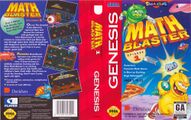 Cover
|
 Cart  Manual |
Technical information
- Main article: Math Blaster: Episode 1/Technical information.
References
